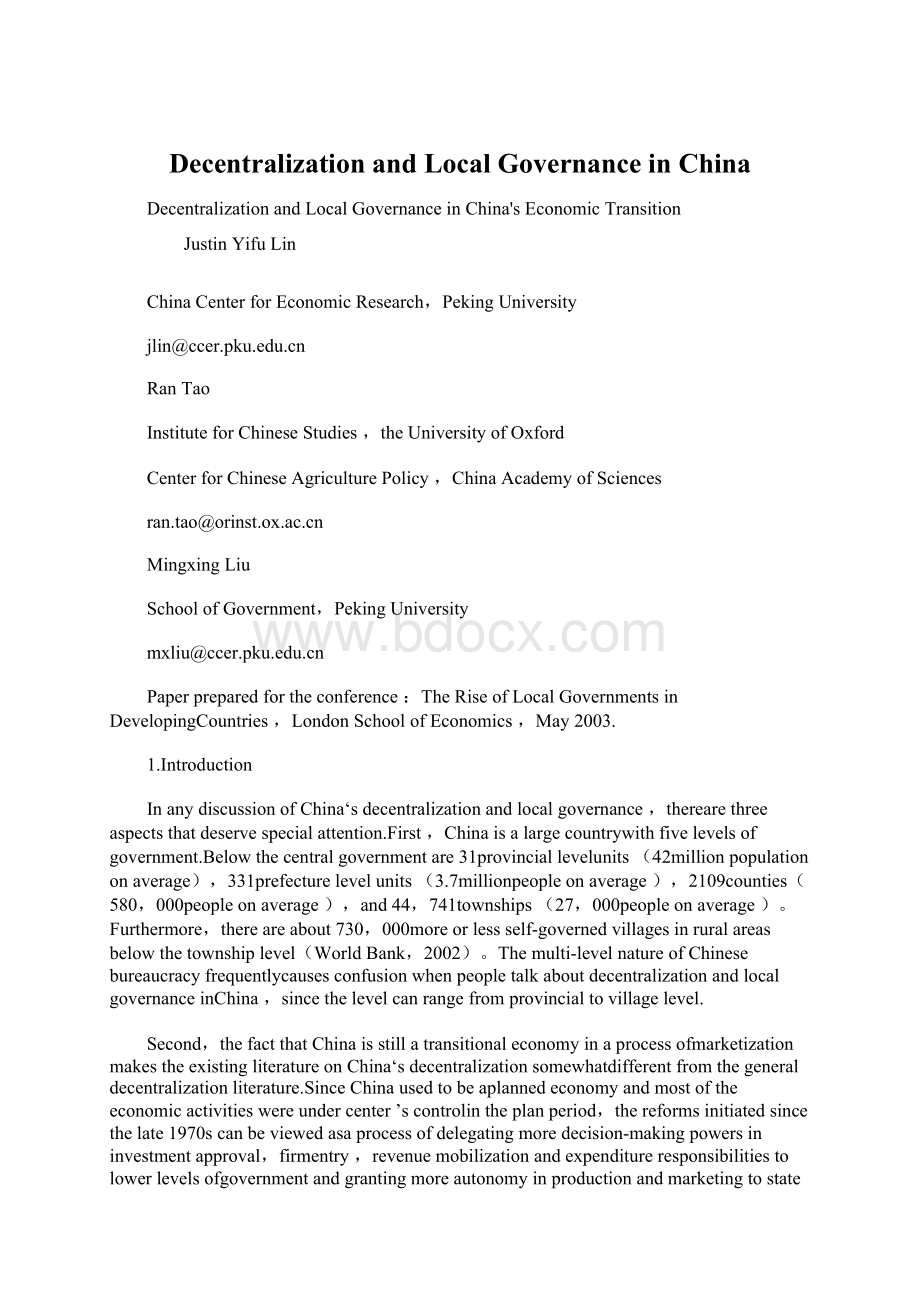Decentralization and Local Governance in China.docx
《Decentralization and Local Governance in China.docx》由会员分享,可在线阅读,更多相关《Decentralization and Local Governance in China.docx(20页珍藏版)》请在冰豆网上搜索。

DecentralizationandLocalGovernanceinChina
DecentralizationandLocalGovernanceinChina'sEconomicTransition
JustinYifuLin
ChinaCenterforEconomicResearch,PekingUniversity
jlin@
RanTao
InstituteforChineseStudies,theUniversityofOxford
CenterforChineseAgriculturePolicy,ChinaAcademyofSciences
ran.tao@
MingxingLiu
SchoolofGovernment,PekingUniversity
mxliu@
Paperpreparedfortheconference:
TheRiseofLocalGovernmentsinDevelopingCountries,LondonSchoolofEconomics,May2003.
1.Introduction
InanydiscussionofChina‘sdecentralizationandlocalgovernance,therearethreeaspectsthatdeservespecialattention.First,Chinaisalargecountrywithfivelevelsofgovernment.Belowthecentralgovernmentare31provinciallevelunits(42millionpopulationonaverage),331prefecturelevelunits(3.7millionpeopleonaverage),2109counties(580,000peopleonaverage),and44,741townships(27,000peopleonaverage)。
Furthermore,thereareabout730,000moreorlessself-governedvillagesinruralareasbelowthetownshiplevel(WorldBank,2002)。
Themulti-levelnatureofChinesebureaucracyfrequentlycausesconfusionwhenpeopletalkaboutdecentralizationandlocalgovernanceinChina,sincethelevelcanrangefromprovincialtovillagelevel.
Second,thefactthatChinaisstillatransitionaleconomyinaprocessofmarketizationmakestheexistingliteratureonChina‘sdecentralizationsomewhatdifferentfromthegeneraldecentralizationliterature.SinceChinausedtobeaplannedeconomyandmostoftheeconomicactivitieswereundercenter’scontrolintheplanperiod,thereformsinitiatedsincethelate1970scanbeviewedasaprocessofdelegatingmoredecision-makingpowersininvestmentapproval,firmentry,revenuemobilizationandexpenditureresponsibilitiestolowerlevelsofgovernmentandgrantingmoreautonomyinproductionandmarketingtostateownedenterprises.Asaresult,muchoftheliteratureonChina‘sdecentralizationactuallydealtwithChina’seconomictransitionandliberalization(seeQianandWeingast1996asanexample),comparedtothegeneralliteratureofdecentralizationthatfocusesonthetransferofpublicfunctionstolowerlevelgovernments.
Third,ChinaisstillaPartyStatewithalllevelsofgovernmentofficialsappointedfromabovebytherulingCommunistParty.UnlikemanyindustrializingcountriesofAfricaorLatinAmericathatareoftenplaguedbybureaucracieslackingexperiencesororganizationalcapacity,theChinesebureaucracyisanelaboratenetworkthatextendstoalllevelsofsociety,downtotheneighborhoodandworkingunit,exhibitingahighdegreeofdisciplinebyinternationalperspective(ParishandWhite,1978,1984)。
Withineachlevelthereexistsanimpressiveorganizationalapparatusthatcouldeffectivelytransmitthestatepoliciesdowntolowerlevelgovernmentagenciesstep-by-stepthroughseverallayersofgovernmentbureaucracy(Oi,1995)。
Onlyinthe1990s,grass-rootelectionstookplaceextensivelyatvillagelevel,whichisnotformallyalevelofgovernment.Therefore,theconceptsof“constitutionaldecentralization”and“politicaldecentralization”donotquitefitinthecaseofChinasinceneitherarethereinstitutionalizedrightsoflocalgovernmentsinthecentraldecision-makingproceduresnoraretherewidelyacceptedgenuineelectionsatandabovethetownshiplevel.
ThispaperfocusesonalimitednumberoftopicsconsideredessentialtounderstandChina‘sdecentralizationandlocalgovernancebytheauthors.Consideringthemulti-levelnatureofChinesebureaucracy,wewillfocusonthedecentralizationandgovernanceissuesatlocallevel,i.e.county,townshipandvillagelevel,whileatthesametimestrivetoillustrateingthestructureandevolutionofinter-governmentalarrangementsathigherlevelsthatconstitutetheinstitutionalbackground.SinceChinaisstillatransitionaleconomy,theChinesestatewasdeeply,andstillis,thoughtoalesserandlesserextent,involvedinsomecompetitivesectorsandintervenesintothesocialandeconomiclivesonmanyfronts.ThedecentralizationprocessinChinahasbeenaccompaniedbyinstitutionalchangessuchasgrantingmorepowerofnon-publicfunctions(suchasinvestmentapproval,entryofnon-statefirms)tolocalgovernments.Givendecentralizationofnon-publicfunctionsconstitutesanimportantelementinChina’seconomictransitionandinmanycasestookplacesimultaneouslywithdecentralizationofpublicfunctions,bothdimensionswillbeexplored.Furthermore,thecentralizedpoliticalsystemnotonlyhavelargelyshapedtheadministrativeandfiscaldecentralizationprocess,butalsoconstitutethebasisforunderstandingmajorlocalgovernanceissuesinChinasuchasunfundedmandatesandfarmer‘staxburdens,ineffectivenessinanti-povertyprogramstobediscussedinthepaper.
Thepaperisstructuredasfollows:
insection2,wereviewthecentralization-decentralizationcyclesintheplanperiodbefore1978andthelogicforsuchcycles.Insection3,adiscussionofadministrativeandfiscaldecentralizationinChina‘smarket-orientedreformssincethelate1970sandtheirimpactsoneconomicgrowth,spatialinequalityandpovertyreductionarepresented.Insection4,wedescribetherecentralizationsince1994andanalyzehowitaffectedlocalpublicfinanceandpublicgoodsprovision.BasedonanalysesofChina’sinter-governmentalfiscalandpoliticalarrangement,section5furtherexplorestwomajorlocalgovernanceissuesinChina,i.e.,un-fundedmandatesandineffectivenessinanti-poverty.PartVIconcludes.
2Centralization-DecentralizationCycleInthePlanPeriod
ThefoundingofthePeople‘sRepublicofChinain1949markedaneweraoftheChinesehistory.Theambitiousgovernmentleadersthenbelievedthattodefendthenewsocialistsystem,andtokeeppaceandevenovertakewesternindustrialcountries,rapidindustrialdevelopment,especiallytheestablishmentofacompletesetofheavyindustrieswasessential.LearningmainlyfromtheSovietexperiences,theChinesegovernmentbegantoformulateandimplementtheFirstFive-yearPlanthatgaveprioritytoheavyindustrialdevelopmentsince1953.
However,developmentofcapital-intensiveindustrieswouldhavebeenextremelycostlyiffreemarketwereallowedtooperateinacapital-scarceeconomy.Tomobilizeresourcesforsuchaheavyindustrialization,aplansystemwasestablished,whichwascharacterizedbyatrinityofamacro-policyenvironmentofdistortedpricesforproductsandessentialfactorsofproduction(e.g.trainedpersonnel,funds,technologies,resources,etc.),highlycentralizedplannedresourceallocationandamicro-managementmechanisminwhichfirmsandfarmershadnodecision-makingpower(Linetal,2003)。
[i]Forinstance,thePeople‘sCommunesystemwassetupintheruralareasinthelate1950stoguaranteestatemonopolyofgrainprocurement.Besidessupplyinggrainatdepressedprices,thecommunesandproductionbrigadeswerealsoresponsibleformobilizingfinancialandhumanresourcesforlocalpublicgoodsprovisions,suchaswaterconservancyconstructionbyorganizingcompulsorylaborservicesoffarmers.
Undertheplansystem,aheavilycentralizedfiscalsystemwasestablished.NotonlytheaccountingsystemsofSOEsweredirectlyincorporatedintogovernmentbudget,butalsomajorresourceswerecontrolledbythecenter.TheStatePlanningCommissioncommandedtheauthorityindetermininglocalrevenueandexpenditureplansonanannualbasis,knownas"unifiedrevenueandunifiedexpenditure"(tongshoutongzhi)。
Localgovernments(atprovince,prefecture,countylevelandcommunelevel)didnothaveindependentbudgets.[ii]Astoexpenditureassignment,thecentralgovernmentwasresponsiblefornationaldefense,economicdevelopment(capitalspending,R&D,universitiesandresearchinstitutes),industrialpolicy,andadministrationofnationalinstitutionssuchasthejudicialsystem.Responsibilitiesfordeliveringday-to-daypublicadministrationandsocialservicessuchaseducation(exceptuniversities),publicsafety,healthcare,socialsecurity,housing,andotherlocal/urbanserviceswasdelegatedtolocalgovernments.
However,inacountryofthesizelikeChina,theworkingloadstoformulate,administrate,coordinate,andmonitorthecentralplanswereextremelyheavyandbecamemoreandmoresoastheeconomicsystembecamelargerandmorecomplicated.Forexample,thenumberofstateownedenterprises(SOEs)subordinatedtothecentralgovernmentincreasedfrom2,800in1953to9,300in1957,andthenumberofitemsinmaterialallocationundercentralplanningincreasedfrom55in1952to231in1957(QianandWeingast1996)。
Theclassicalproblemofcontrolandmonitoringunderinformationasymmetryemergedsoonaftertheplannedsystemwassetup.Astheeconomygrewlargerwithmoreprojectsinitiatedandenterprisesstarted,theplansystembecameincreasinglyunmanageable.Tomakethingsworse,ahighlycentralizedplannedsysteminevitablyunderminedtheincentivesoflocalgovernmentswhenlocalcoordinationinindustrialdevelopmentwasessential.
Underthisbackground,Chinainitiateditsfirstdecentralizationwithintheplannedframeworkbydelegatingmorepowerstolocalgovernmentsin1957.Thepoliciesthenincluded:
(1)delegatingnearlyallSOEstolocalgovernments,suchthattheshareofindustrialoutputbytheenterprisessubordinatedtothecentralgovernmentshrankfrom40percentto14percentofthenationaltotal;
(2)centralplanningwastochangefromanationaltoaprovincialbasis,withdecisionsaboutfixedinvestmenttobemadebylocalgovernmentsratherthanthecentralgovernment;(3)revenuesharingschemeswerefixedforfiveyearsandlocalgovernmentsweregrantedsomeauthorityovertaxes.T